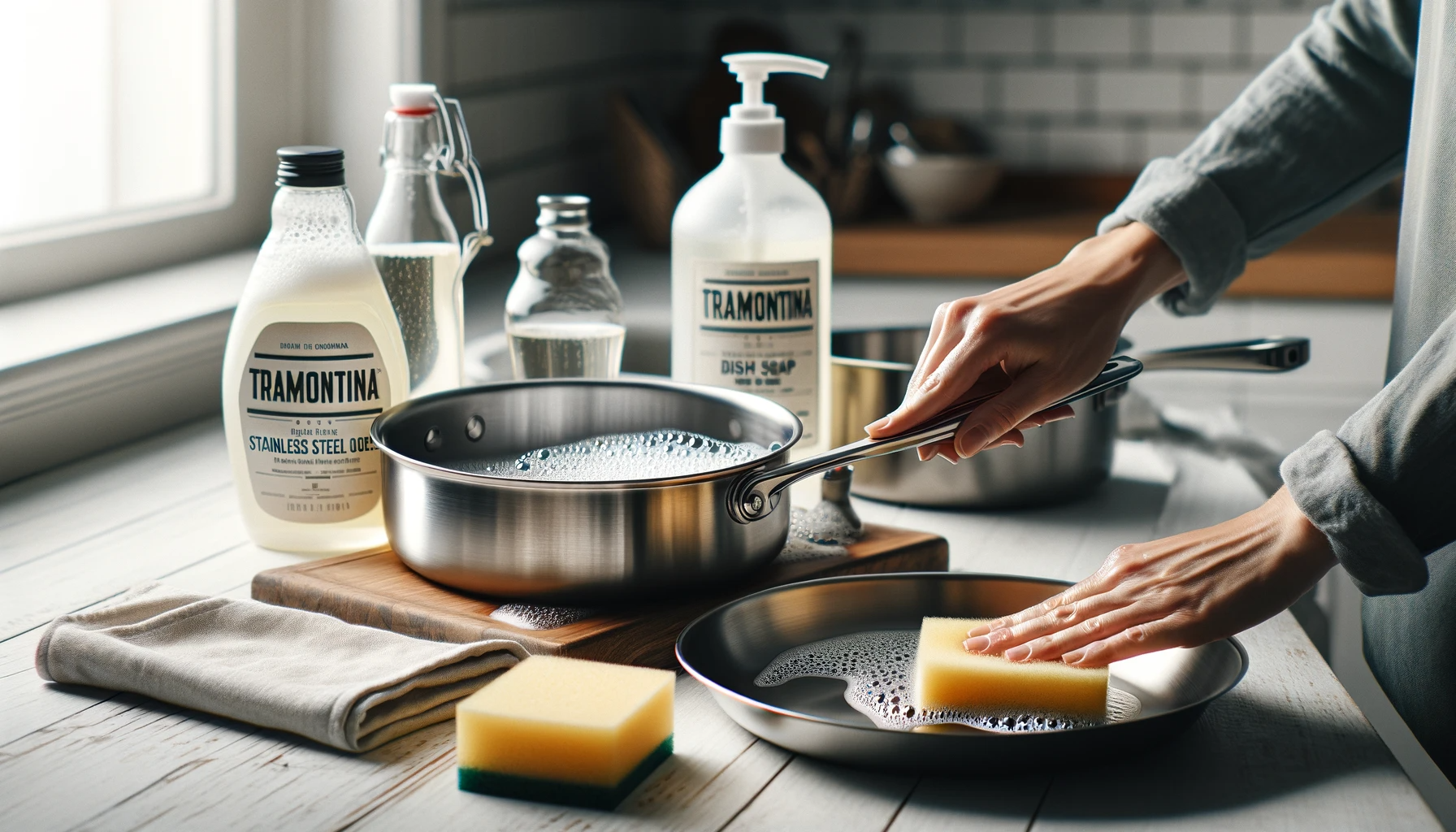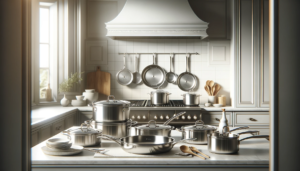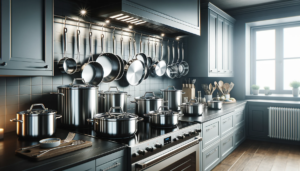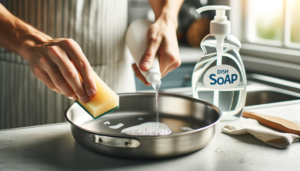Tired of scrubbing away at sticky stains marring the shiny stainless steel surface of your Tramontina cookware? Learn how a few humble kitchen staples make cleaning and caring for these pots and pans simple.
Proper cleaning and care is essential for Tramontina stainless steel cookware to maintain its beauty and cooking functionality over decades of use.
Let’s dive into gathering supplies, tackling interior and exterior grime, removing stubborn stains, and preventative steps for making Tramontina last.
How to Clean Tramontina Stainless Steel Cookware
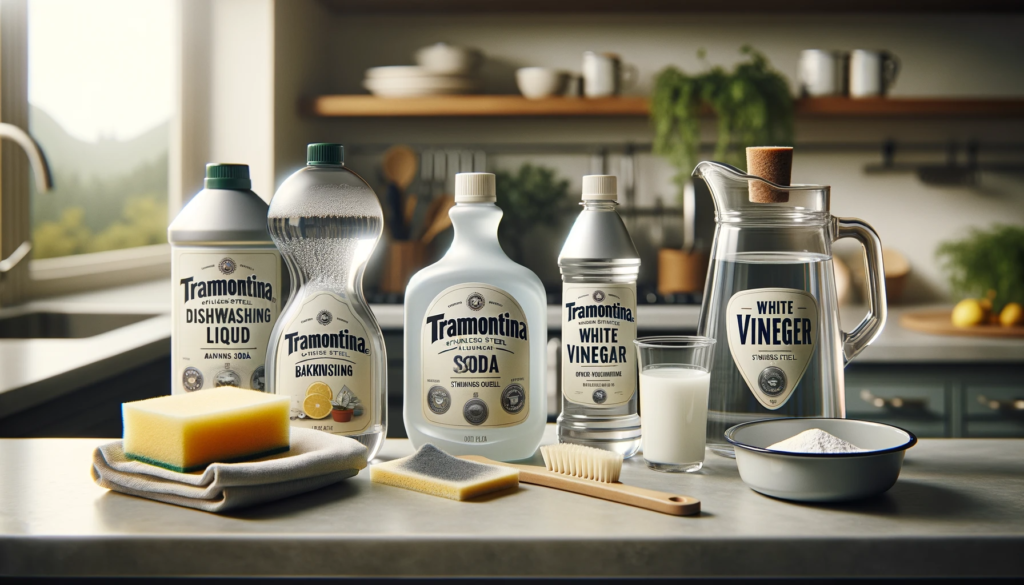
To clean Tramontina stainless steel pots and pans, use a soft sponge or cloth with hot water and dish soap to gently scrub away food residue and grease from interior cooking surfaces.
For the exteriors, make a baking soda paste and wipe down the outside to lift stains and restore shine.
To tackle really stubborn interior burnt bits or stains, let cookware soak in an equal parts vinegar and water solution before scrubbing.
Always be sure to thoroughly rinse and hand dry cookware after washing to prevent water spots.
In the below, we’ll explore specifics on supplies needed, interior and exterior gentle scrubbing methods, conquering extreme stains, and maintaining this durable cookware’s beauty over decades of cooking enjoyment.
Let’s get started!
Gathering the Necessary Supplies
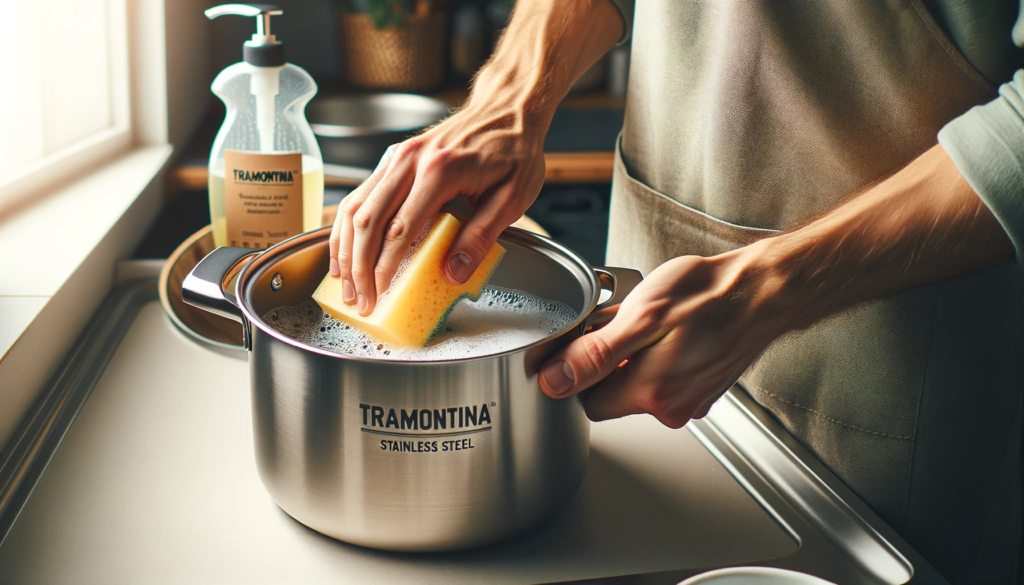
Having the right cleaning supplies on hand is essential for properly caring for Tramontina stainless steel pots and pans.
As you prepare to refresh dirty cookware after cooking, be sure to gather:
- Dishwashing liquid or detergent – Forget harsh scrubbing powders or acidic cleaners; a mild additive-free liquid dish soap that’s safe for hands is all you need.
- Dishwashing liquid helps cut through oil and grease residue without damaging stainless steel over time when used properly.
- Soft sponge or dishcloth – Gentle cleaning is key for stainless steel, so have ready a soft dish sponge or a couple lint-free dishcloths.
- Avoid abrasive scrubbing pads or brushes, as they can scratch and damage polished cookware finishes.
- Baking soda – For exterior surfaces, baking soda’s mild abrasiveness helps lift cooked-on gunk and restore shine without risk of scratches.
- Sprinkle it dry or mix with water to form a scrubbing paste.
- White vinegar – The acetic acid in vinegar gently dissolves stubborn, stuck-on food residue and stains on interior surfaces when combined with soaking.
- Undiluted vinegar is best for serious grime-fighting power.
- Water – Hot water from the tap helps soften cooked-on messes so they can be gently scrubbed away.
- Cool water thoroughly rinses cleaner residue.
- Ensure your cookware dries fully to prevent water spots.
- Stainless steel polish (optional) – While not strictly necessary every time, occasional use of polish protects the exterior finish between deeper cleanings.
With these basic kitchen staples on hand, you have everything needed to make Tramontina stainless steel sparkle once more.
Now let’s get to cleaning!
Scrubbing Away Grime from Interior Surfaces
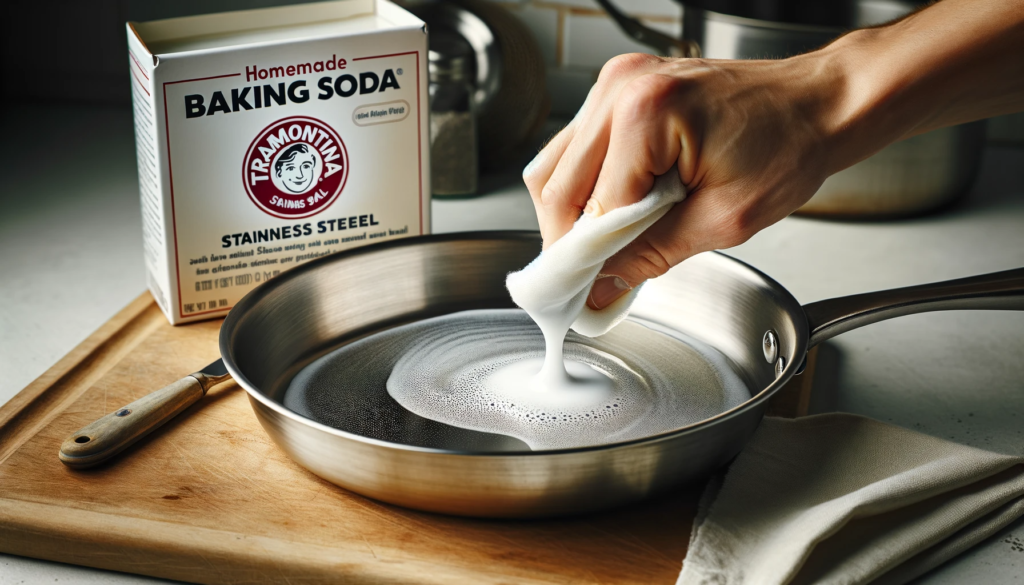
During the cooking process, the insides of your Tramontina stainless steel pots and pans really take a beating.
Sauces, oils, and food residue stick, stubbornly clinging to once-pristine cooking surfaces.
But have no fear – with some hot water, elbow grease, and proper technique, you can have your cookware interiors looking brand new again in no time!
Start by filling up each dirty pan with hot water from the faucet until full.
Water levels should sufficiently cover any cooked-on grime or food debris inside.
To this, squirt a small amount of additive-free dishwashing liquid, enough to create some bubbles and suds when agitated.
With a soft dish sponge or cloth in hand, gently scrub the interior of the cookware, focusing on any visible stuck-on stains or deposits.
The hot soapy water solution helps soften and lift residue without harsh chemicals or abrasives that could damage the finish over time.
Be sure to get into corners, along sides, and over the base of the cookware too using gentle circular motions.
Repeatedly dip your soft sponge into the soapy water to prevent redepositing grime back onto clean areas.
Pay extra attention to cooked-on spots by focusing additional scrubbing there, allowing the sudsy water to penetrate before attempting to wipe away.
Once the inside appears free of stuck-on food or cloudy oil residue, carefully empty the wash water from the cookware.
Thoroughly rinse the interior several times with clean hot water, ensuring no lingering suds or cleaning product remains behind.
These can negatively impact stainless steel’s appearance and performance if allowed to accumulate over time.
Finally, use a fresh lint-free dish towel to carefully hand dry the inside of each piece of cookware.
While air drying is an option, allowing stainless steel to repeatedly sit wet can lead to mineral deposits and water spots, marring its fine finish.
So always dry thoroughly!
Restoring Exterior Beauty
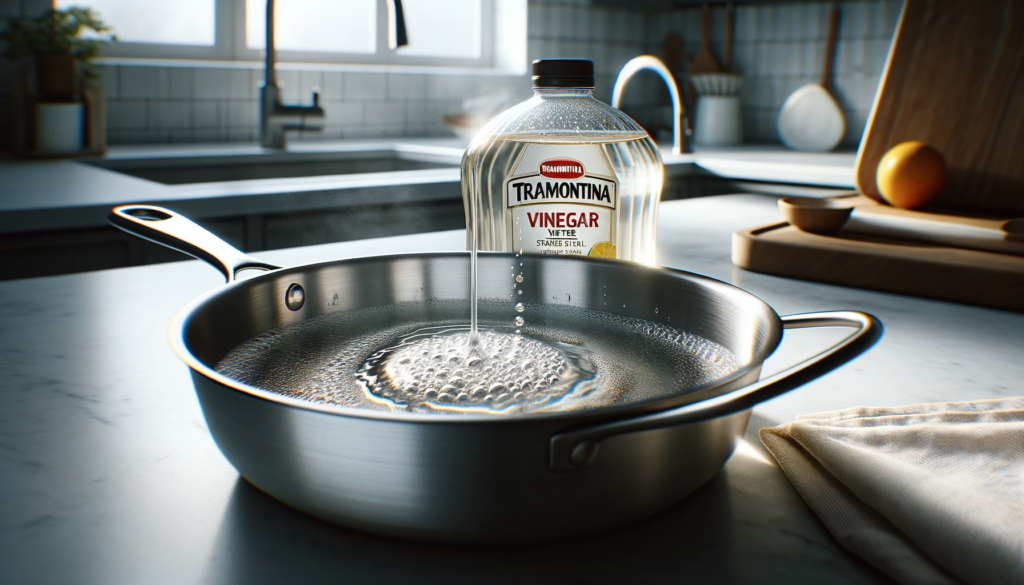
While interiors surely take a beating, don’t forget that exterior surfaces need cleaning too.
Inadvertent greasy fingerprints, errant food splatters, accumulated dust and grime – all can make Tramontina’s beautiful brushed finish appear dull and lackluster over time.
Restore exterior shine and remove smudges, spots and residue by making a simple paste of baking soda and water.
Start by generously sprinkle baking soda into a small bowl, piling a few heaping tablespoons worth to start.
Slowly mix in cool water a little bit at a time, stirring continually with a fork or spoon.
You want to achieve a thick, spreadable paste consistency without being overly runny or diluted.
Baking soda provides mild abrasiveness effective at lifting dirt and residue, while the small amount of moisture allows for more even dispersion and friction as you scrub.
Using a soft dish sponge, old toothbrush, or lint-free cloth, apply the baking soda paste liberally to coat the entire outside surface of your Tramontina cookware.
Try to cover handles, knobs, bases and vertical sides evenly for comprehensive cleaning action.
Allow the paste to sit briefly before scrubbing to penetrate built up grime.
Then, gently rub the exterior in small circular motions using your chosen implement to lift debris from the microscopic crevices of Tramontina’s signature brushed finish textures.
Pay extra attention to areas more prone to oil splatters and fingerprints for deeper stain removal.
Reapply paste as needed to prevent dragging grime to clean areas.
Once satisfied with the scrubbing results, thoroughly rinse away all traces of baking soda from the cookware exterior by holding under cool running water.
Wipe any lingering moisture away with a dry dish towel for a flawless streak-free finish.
Allowing exterior stainless steel surfaces to air dry after washing risks mineral deposits in water droplets leaving behind white haze or water spots.
Tackling Stubborn Interior Stains and Burnt Debris
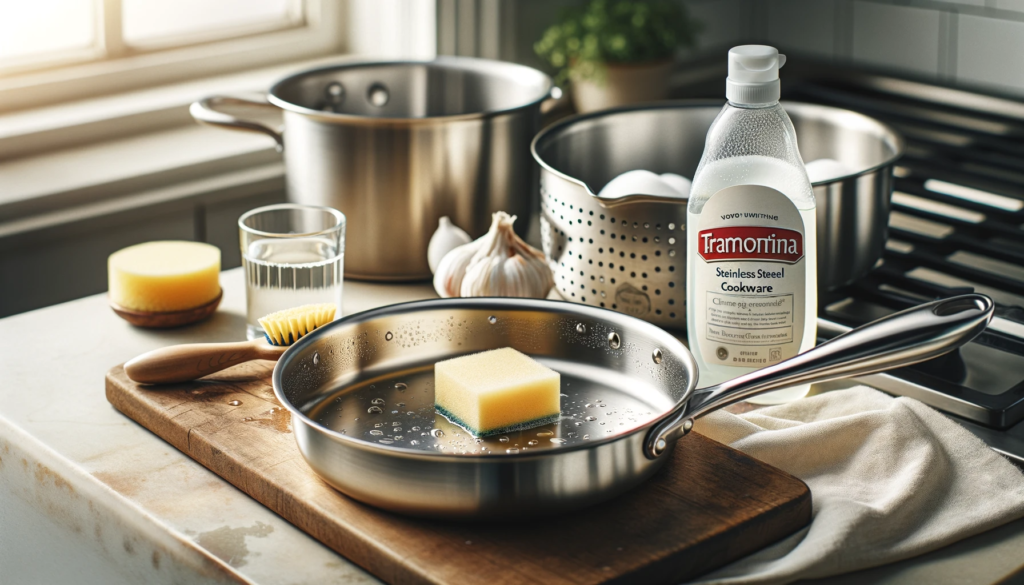
Sometimes extra measures are needed when facing down extremely stubborn, stuck-on stains and burnt bits inside well-loved Tramontina pans.
Enter white distilled vinegar – with some extended soaking time, vinegar’s acetic acid works to gently dissolve what typical washing methods cannot on their own.
Start by filling each stained pot or pan with equal parts undiluted vinegar and hot water from the tap.
Water should fully submerge affected areas, while straight vinegar provides maximum stain-fighting acidity.
Allow pans to soak for at least 30 minutes up to a few hours for extreme situations.
Periodically check cooking surfaces – you should notice stuck-on debris beginning to break down over time and loosening its grip.
Once ready, use a dish sponge or soft cloth to gently scrub soiled areas, coaxing grime into dissolution without abrasive force.
Repeat extended soaking if needed for most stubborn deposits.
When the interior again looks clean and free of buildup, carefully empty the vinegar solution down the drain.
Thoroughly rinse the cookware with lots of fresh clean water to eliminate any lingering acidic smell or taste residue from vinegar.
Remember to completely hand dry interiors once more for sparkling results sans water spots.
Now behold almost-new looking Tramontina stainless steel cookware interiors once again! Yet don’t forget…an ounce of prevention is worth a pound of cure when it comes to keeping your beloved pots and pans looking pristine.
Maintaining Beauty Over Time
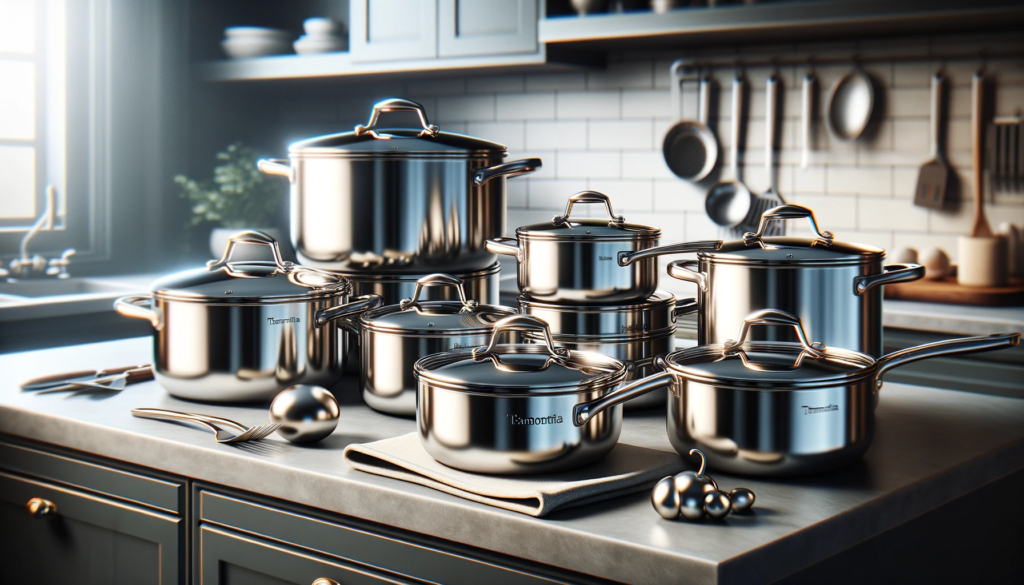
With proper preventative care steps, you should not find yourself needing intense stain removal too frequently.
Regular gentle cleaning, maintenance polishing, and proper practices preserve Tramontina’s integrity and beauty for the long haul.
Treat your quality cookware right, and it will last for decades of cooking enjoyment.
Be sure to hand wash Tramontina pieces after each use.
Immediately rinsing food debris prevents stains from setting and building up over time.
Use soft dish sponges or cloths only when scrubbing to avoid micro abrasions that allow grime ingress.
Always thoroughly dry pieces instead of allowing air drying to prevent mineral deposits.
Additionally, applying a stainless steel polish or cleaner every so often provides a protective barrier against fingerprints and water stains on exterior surfaces between deeper cleanings.
Affordable polishes are available from most grocery and home goods stores.
Gently rub a dime-sized amount of polish into exterior cookware surfaces using small circular motions following the direction of brushed grain finishes.
Then rinse and hand dry thoroughly.
By regularly gently cleaning and occasionally polishing your Tramontina stainless steel pots and pans after each use, you reinforce the protective layer keeping grime from adhering to surfaces.
Cookware keeps its freshly polished sheen much longer instead of requiring intense scrubbing each time.
Your preventative efforts enhance both beauty and lifespan of beloved pieces.
Conclusion
Caring for your Tramontina stainless steel cookware properly takes just a little effort but pays off for decades through enduring beauty and cooking performance.
Using the gentle cleaning and maintenance methods detailed here, you can keep your pots and pans sparkling like new to become treasured kitchen staples.
